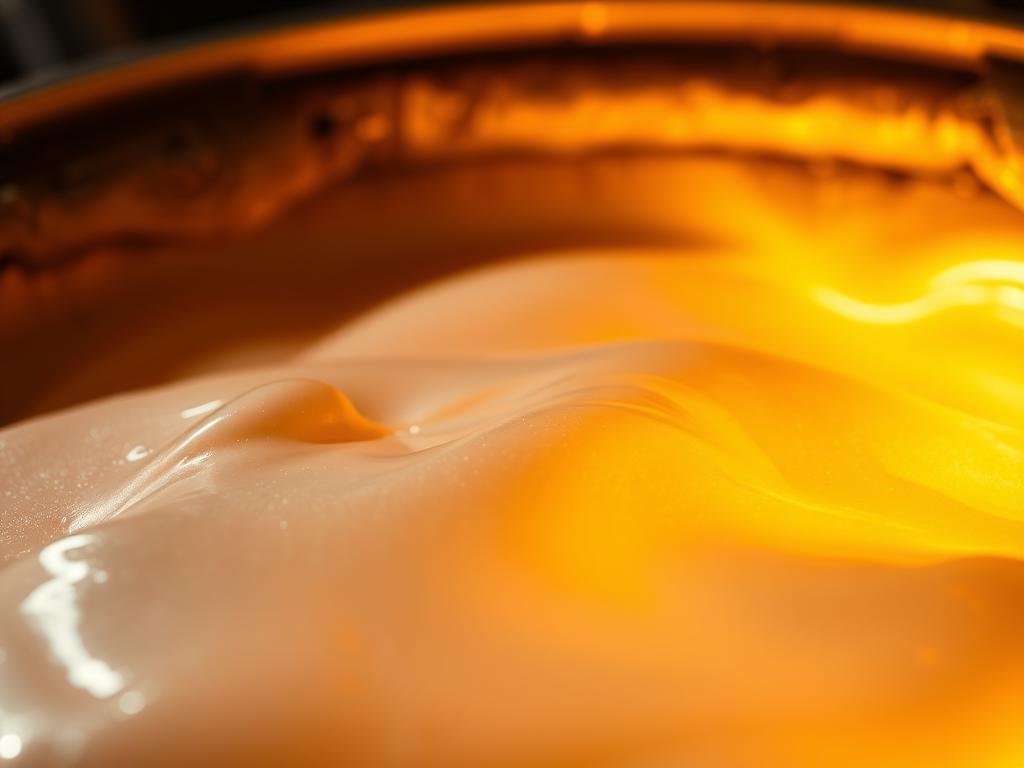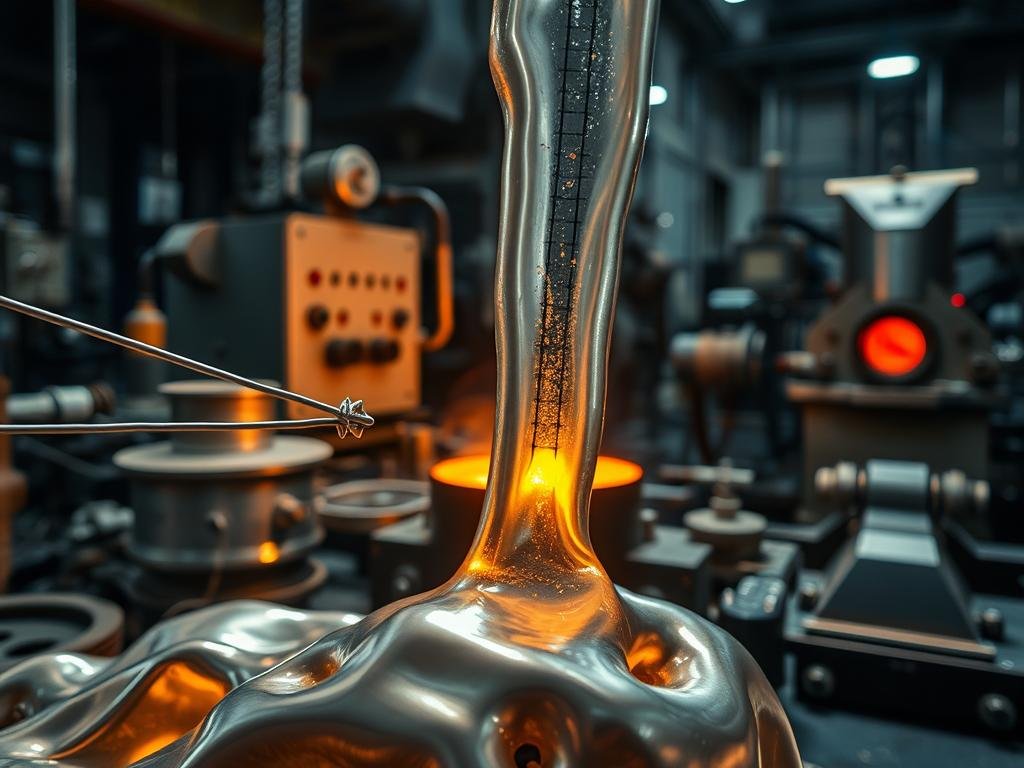The melting point of silver, approximately 961.8°C (1,763.2°F), is a crucial property that influences its use in various industries, from jewelry making to electronics.
Understanding the temperature required to melt silver is vital for craftspeople and manufacturers working with this precious metal. Compared to other metals like gold (1,064°C) and lead (327.5°C), silver’s relatively low melting point gives it unique properties suitable for specific applications.
This comprehensive guide will explore the scientific aspects of silver’s melting behavior, factors affecting it, and techniques for properly melting silver in different contexts, ensuring proper handling of this valuable material.
Understanding Silver’s Physical Properties
Understanding the physical properties of silver is crucial for harnessing its potential in different fields. Silver’s characteristics, such as its high thermal conductivity and ductility, make it a valuable material in various industries.
Key Characteristics of Silver
Silver is known for its exceptional thermal and electrical conductivity, making it a critical component in electronics and other applications. Its high ductility allows it to be easily shaped and molded without breaking.
- High thermal and electrical conductivity
- Ductility and malleability
- High reflectivity and brightness
The Exact Melting Point of Silver
The melting point of pure silver is 961.8°C (1,763.2°F), a critical temperature that marks the transition from solid to liquid. This precise melting temperature is essential for processes like casting and refining.
- The precise melting point of silver is 961.8°C (1,763.2°F or 1235K).
- This temperature is crucial for calibrating equipment used in silver processing.
- The melting point represents the energy required to break the metallic bonds holding silver’s crystalline structure together.
Silver Melting Point: The Scientific Explanation
Understanding the melting point of silver requires a deep dive into its atomic structure and the nature of metallic bonding. The melting point is a critical physical property that determines the temperature at which silver transitions from a solid to a liquid state.
Atomic Structure and Metallic Bonding
Silver’s atomic structure is characterized by a face-centered cubic crystal lattice, where each atom is surrounded by twelve nearest neighbors. The metallic bonding in silver is responsible for its high thermal conductivity and ductility. When silver is heated to its melting point, the energy absorbed is used to break the metallic bonds, allowing the atoms to move more freely.
The heat of fusion for silver is 11.28 kJ/mol, indicating the energy required to change its state from solid to liquid at the melting point. This process is a first-order phase transition, characterized by a discontinuous change in density and the absorption of a fixed amount of energy.
Phase Transition from Solid to Liquid
At the melting point of 961.8°C, silver absorbs heat energy while maintaining a constant temperature until the entire sample has melted. This phenomenon occurs because the energy is used to break the metallic bonds rather than increase the kinetic energy of the atoms. The melting process begins at the surface and grain boundaries, where atoms have fewer bonds to neighboring atoms.
| Property | Value |
|---|---|
| Melting Point | 961.8°C |
| Heat of Fusion | 11.28 kJ/mol |
As silver transitions through its melting point, there is a coexistence of both solid and liquid phases until sufficient energy has been absorbed to complete the phase change. Understanding this phase transition is crucial for controlling the melting process in various applications.

Factors Affecting Silver’s Melting Point
Several key factors can affect the melting point of silver, making it crucial to understand these elements for precise applications. The melting behavior of silver is influenced by both its composition and external environmental conditions.
Purity and Alloy Composition
The purity of silver and its alloy composition significantly impact its melting point. Pure silver, or fine silver, has a well-defined melting point, whereas alloys like sterling silver have a range of melting temperatures due to the presence of other metals.
| Silver Type | Melting Point (°C) |
|---|---|
| Fine Silver (999) | 961.8 |
| Sterling Silver (925) | 893-903 |
Environmental Conditions and Pressure
Environmental conditions, particularly atmospheric pressure, can also influence the melting point of silver. At higher pressures, the melting point tends to increase. The relationship between pressure and melting point is described by the Clausius-Clapeyron equation.
Understanding how environmental conditions affect silver’s melting point allows metallurgists to adjust processing parameters accordingly to achieve consistent results across different operating environments.
Different Types of Silver and Their Melting Points
The versatility of silver is evident in its numerous alloys, which have different melting points. These variations in melting points are crucial for various applications, from jewelry making to industrial uses.
Fine Silver (999)
Fine silver, with a purity of 99.9%, has a melting point of approximately 961.8°C (1763.2°F). Its high purity makes it an ideal choice for certain applications where ductility and conductivity are paramount.
Sterling Silver (925)
Sterling silver, an alloy containing 92.5% silver and 7.5% other metals (usually copper), has a slightly lower melting point than fine silver, around 893-903°C (1639-1657°F). The addition of other metals enhances its strength and durability.
Other Silver Alloys
Beyond sterling silver, there are numerous other silver alloys with varying compositions and melting points. For instance, Britannia silver (95.8% silver) melts at approximately 940°C (1724°F), while Argentium silver, a modern alloy containing germanium, has a melting point around 930°C (1706°F). Silver solders, used for soldering, have lower melting points, typically between 600-750°C. The diversity in silver alloys allows for a wide range of applications, from jewelry and coins to industrial and dental uses.
Comparing Silver’s Melting Point to Other Metals
Understanding how silver’s melting point compares to other metals is crucial for various industrial and manufacturing processes. Silver’s melting point of 961.8°C places it in a unique position relative to other metals, affecting its applications and processing.
Precious Metals Comparison
When comparing silver to other precious metals, its melting point is relatively moderate. For instance, gold has a melting point of 1,064°C, which is about 102°C higher than silver. This difference is significant in refining and alloying processes. In contrast, platinum has a much higher melting point at 1,768.3°C, making silver more manageable for jewelry making and other applications where high-temperature resistance is not required.
Industrial Metals Comparison
Silver’s melting point is also noteworthy when compared to common industrial metals. It is higher than metals like aluminum (660.3°C), lead (327.5°C), zinc (419.5°C), and tin (231.9°C), but lower than copper (1,084°C), iron (1,538°C), and titanium (1,668°C). This positioning makes silver versatile for many manufacturing processes, neither too difficult to melt like tungsten nor too easily melted like tin. The differences in melting points have practical implications for processing sequences and material compatibility in industrial applications.
Applications Requiring Knowledge of Silver’s Melting Point
The precise melting point of silver is vital information for various industrial and medical applications. Understanding this property is essential for ensuring the quality and safety of products that utilize silver.
Jewelry Making and Silversmithing
In jewelry making and silversmithing, knowledge of silver’s melting point is crucial for crafting and shaping silver into intricate designs. Artisans must carefully control temperature to achieve the desired form without compromising the metal’s integrity.
Industrial and Electronic Applications
Silver’s high melting point makes it an ideal material for various industrial and electronic applications, including the manufacture of contacts, switches, and conductive pastes. Its excellent thermal conductivity also makes it useful in heat sinks and other thermal management systems.
Medical and Scientific Uses
Silver’s antimicrobial properties make it valuable in medical applications, such as wound dressings and medical devices. The melting point of silver influences the manufacturing processes for these products, ensuring that they are produced at temperatures that preserve their antimicrobial efficacy. 
In scientific research, silver’s well-defined melting point serves as a calibration standard for thermal analysis equipment, further highlighting its importance across different fields.
Practical Guide to Melting Silver
The process of melting silver is complex and requires a thorough understanding of the materials and techniques involved. To ensure high-quality results, it’s essential to follow a well-structured approach.
Equipment and Tools Needed
To melt silver safely and effectively, you’ll need a few key pieces of equipment. A crucible made from a heat-resistant material is essential for holding the silver as it melts. A furnace or torch capable of reaching high temperatures is also necessary. Additionally, protective gear such as heat-resistant gloves and safety goggles are crucial for preventing injury. Make sure all equipment is clean and in good condition to prevent contamination.
Step-by-Step Melting Process
The melting process involves several critical steps. First, ensure your silver is properly prepared and free of contaminants. Next, place the silver in the crucible and heat it gradually using your chosen heating method. Monitor the temperature closely to avoid overheating. Once the silver is molten, use a flux to remove any impurities and achieve a smooth, consistent melt.
Common Challenges and Solutions
Several challenges can arise when melting silver, including oxidation, porosity, and contamination. To mitigate these issues, use a protective flux to prevent oxidation, ensure materials are dry to avoid porosity, and maintain cleanliness to prevent contamination. By understanding these common challenges and their solutions, you can improve the quality of your molten silver and achieve more consistent results.
As a safety note, “Smelting can produce toxic fumes from the flux and other chemicals used, so it’s essential to work in a well-ventilated area and wear protective gear.” By following these guidelines and being aware of the potential challenges, you can ensure a safe and successful silver melting process.
Conclusion
Understanding the melting behavior of silver is essential for optimizing its use in diverse industries. The silver melting point of 961.8°C represents a fundamental physical property that has shaped how this precious metal has been used throughout human history. From jewelry making to electronics, the melting point of silver influences its processing, casting, and application in various fields.
Factors such as purity, alloying elements, and environmental conditions affect silver’s melting point, demonstrating the complexity of material science. Modern applications of silver continue to evolve, relying on the fundamental understanding of its melting behavior as a starting point for developing processing techniques. As technology advances, silver’s excellent conductivity and moderate melting point ensure it will remain important in emerging industries and energy applications.
In conclusion, the melting point of silver is a critical property that directly influences its utility, processing requirements, and ultimate applications across diverse fields. By understanding and utilizing this information, manufacturers can enhance the quality and functionality of silver products, ensuring that silver remains a vital material in various industries.
